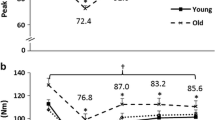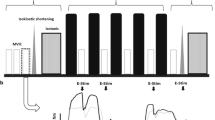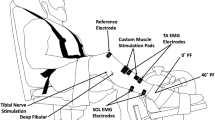Summary
The purpose of the present study was to determine if old individuals show a greater exercise-induced decrement in motor performance and slower recovery compared to young individuals. Ten college-age women (23.6 years) and ten older women (67.4 years) performed an exercise consisting of 24 eccentric actions of the forearm flexors. In young subjects, eccentric exercise is known to produce repairable muscle damage. Before the exercise and for 5 days after, isometric strength, soreness, reaction time, and movement time were measured. For both groups, strength was reduced and soreness developed in the days following the exercise, generally indicating that muscle damage had occurred. The older subjects showed a slower strength recovery such that by 5 days after exercise they had not returned to their initial level of strength. There was no significant difference in soreness development between groups. Reaction time and movement time were not adversely affected by the exercise. Thus, the older subjects demonstrated a slower strength recovery after damage-inducing exercise, and, with regard to response speed, the older subjects could compensate for the impaired muscle function as well as the younger subjects.
Similar content being viewed by others
References
Aniansson A, Grimby G, Hedberg M, Rundgren A, Sperling L (1978) Muscle function in old age. Scand J Rehabil Med [Suppl] 6:43–49
Baylor AM, Spirduso WW (1988) Systematic aerobic exercise and components of reaction time in older women. J Gerontol 43:121–126
Botwinick JE, Thompson LW (1966) Components of reaction time in relation to age and sex. J Genet Psychol 108:175–183
Clarkson PM (1978) The effect of age and activity level on simple and choice fractionated response time. Eur J Appl Physiol 40:17–25
Clarkson PM, Dedrick M (1988) Exercise-induced muscle damage, repair, and adaptation in old and young subjects. J Gerontol 43:91–96
Clarkson PM, Tremblay I (1988) Exercise-induced muscle damage, repair, and adaptation in humans. J Appl Physiol 65:1–6
Davies CTM, White MJ (1981) Muscle weakness following eccentric work in man. Pflügers Arch 392:168–171
Friden J, Sjostrom M, Ekblom B (1983) Myofibrillar damage following intense eccentric exercise in man. Int J Sports Med 4:170–176
Grimby G, Saltin B (1983) Mini review: the ageing muscle. Clin Physiol 3:209–218
Grimby G, Danneskiold-Samsoe B, Hvid K, Saltin B (1982) Morphology and enzymatic capacity in arm and leg muscles in 7881 year old men and women. Acta Physiol Scand 115:125–134
Hart BA (1981) The effect of age and habitual activity on the fractionated components of resisted and unresisted response time. Med Sci Sports Exerc 13:78
Jarvinen M, Aho AJ, Lehto M, Toivonen H (1983) Age dependent repair of muscle rupture. Acta Orthop Scand 54:64–74
Klimovitch G (1977) Startle response and muscular fatigue effects upon fractionated hand grip reaction time. J Mot Behav 9:285–292
Kroll W (1974) Fractionated reaction and reflex time before and after fatiguing isotonic exercise. Med Sci Sports Exerc 6:260–266
Kroll W, Clarkson PM (1978) Age, isometric knee extension strength, and fractionated resisted response time. Exp Aging Res 4 (5):389–409
Larsson L, Grimby G, Karlsson J (1979) Muscle strength and speed of movement in relation to age and muscle morphology. J Appl Physiol 46:451–456
Newham DJ, Jones DA, Edwards RHT (1983a) Large delayed plasma creatine kinase after stepping exercise. Muscle Nerve 6:380–385
Newham DJ, Mills KR, Quigley BM, Edwards RHT (1983b) Pain and fatigue after concentric and eccentric muscle contractions. Clin Sci 64:55–62
Newham DJ, McPhail G, Mills KR, Edwards RHT (1983c) Ultrastructural changes after concentric and eccentric contractions of human muscle. J Neurol Sci 61:109–122
Newham DJ, Jones DA, Clarkson PM (1987) Repeated high force eccentric exercise: effects of muscle pain and damage. J Appl Physiol 63:1381–1386
Schwane AJ, Johnson SR, Vandenakker CB, Armstrong RB (1983) Delayed onset muscular soreness and plasma CPK and LDH activities after downhill running. Med Sci Sports Exerc 15:51–56
Sheerer N, Berger RA (1972) Effects of various levels of fatigue on reaction time and movement time. Am Correct Ther J 26:146–147
Spirduso W (1975) Reaction and movement time as a function of age and physical activity level. J Gerontol 30:435–440
Stull GA, Kearney JT (1978) Effect of variable fatigue levels on reaction-time components. J Mot Behav 10:223–231
Author information
Authors and Affiliations
Rights and permissions
About this article
Cite this article
Dedrick, M.E., Clarkson, P.M. The effects of eccentric exercise on motor performance in young and older women. Europ. J. Appl. Physiol. 60, 183–186 (1990). https://doi.org/10.1007/BF00839156
Accepted:
Issue Date:
DOI: https://doi.org/10.1007/BF00839156




